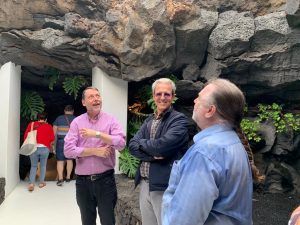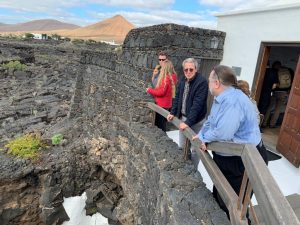CÉSAR MANRIQUE: SHEPHARD OF ZEPHERS AND VOLCANOES
by Scott Hightower · March 07, 2019 CÉSAR MANRIQUE (1919-1992), the Spanish artist: painter, sculptor, architect, may not be known to many… so let this be an introduction. He was born on Lanzarote, one of eight islands that comprise the Canarias. In the latter part of the twentieth century, Manrique, an artist with an energetic vision, emerged as one of Lanzarote’s most successful diplomatic voices; a title he posthumously most likely still holds today. His ubiquitous presence and influence on Lanzarote is much like that of Frank Lloyd Wright’s in the United States or Santiago Calatrava’s in Valencia, Spain.
CÉSAR MANRIQUE (1919-1992), the Spanish artist: painter, sculptor, architect, may not be known to many… so let this be an introduction. He was born on Lanzarote, one of eight islands that comprise the Canarias. In the latter part of the twentieth century, Manrique, an artist with an energetic vision, emerged as one of Lanzarote’s most successful diplomatic voices; a title he posthumously most likely still holds today. His ubiquitous presence and influence on Lanzarote is much like that of Frank Lloyd Wright’s in the United States or Santiago Calatrava’s in Valencia, Spain.
Lanzarote is a Spanish island that is geographically closer to Morocco than it is to Cadiz. It is a tropical volcanic island with sublime vistas. The primary colors of the land are ochre or volcanic black. Many of its vistas and features are Andy Goldsworthy worthy.
Besides island ocean-beachfront, many vistas contain steep valleys dotted with arid pyroclastic fields, small fertile patches comprised of socos (stone walls protecting grape vines and fig trees from drying breezes), and palm tree villages that look like desert oases. One can consider what the Sahara Desert must have looked like when it was fertile and green. Or what the countryside of Santa Fe, New Mexico, with its desert mountains and vistas, might be if it were dropped down to a tropical location, strewn with stones of lava, and dotted with palm trees.
Manrique, after completing a two-year Rockefeller fellowship in New York City (1964-1966), returned to Lanzarote to construct two homes; both of which are contemporary destination sites of pilgrims. Both of which creatively employ local materials and building techniques indigenous to Lanzarote. Manrique’s structures are fantastic expressions of shelter,

perch, vista, and shade employing materials and technologies familiar to the island. There are basalt craters, pools, walkways, walls, cabins, kivas, and domes. They employ the technology shipbuilders use to secure beams, columns, and masts of wood; that sailors use to hoist, hang and secure sails: wheels, winces, cables, and grommets; technologies sensitive to the spin of axel and the elements of wind, light, and gravity.  Sunlight courses down volcanically created stone walls. Indigenous flowering plants and cacti are complements in the décor and fill the planters and beds of the patios, terraces, and gardens.
Sunlight courses down volcanically created stone walls. Indigenous flowering plants and cacti are complements in the décor and fill the planters and beds of the patios, terraces, and gardens.
 One site is in the village of Tahiche, just north of Arrecife. Seven days a week cars and tourist buses arrive so that interested travelers may wind through the house, exhibition, pool, and gardens. The house is located in the harsh landscape of a lava field. Comprised of five chambers formed by escaping volcanic bubbles. The chambers are interconnected with tunnels. Beyond the indigenous elements, the house is an interesting expression of 70s pop modernism.
One site is in the village of Tahiche, just north of Arrecife. Seven days a week cars and tourist buses arrive so that interested travelers may wind through the house, exhibition, pool, and gardens. The house is located in the harsh landscape of a lava field. Comprised of five chambers formed by escaping volcanic bubbles. The chambers are interconnected with tunnels. Beyond the indigenous elements, the house is an interesting expression of 70s pop modernism.
The other site is in Haria, a small village further north, in a palm-dotted volcanic valley. Both can be visited in a single day. One often elects to travel on to Mirador del Río or the restaurant at Timanfaya National Park, both perches with incredible vistas. Or one can eat lunch at the Museum of the Campesino, all designed by the indefatigable César Manrique.
Two other celebrated Manrique public wonders are the Jameos del Agua (a semi-collapsed lava tube) with its subterranean salt lake, gardens, restaurant, and auditorium; and the Jardín de Cactus, a structure-landscaping collaboration with the botanist Estanislao González Ferrer.
I wish to thank Coty Lavandera, Luis Sánchez Chamorro, and José Juan Ramírez (the President of the César Manrique Foundation) for taking time out of their busy schedules to personalize my tour. In particular, I would like to thank José Juan Ramírez, who, while generously guiding me through the intricacies of the Tahiche home and guardens, evoked the young César Manrique of Lanzarote—future artist (painter, sculptor, architect)––as a boy enraptured in one of his wonderous studies of ants.
